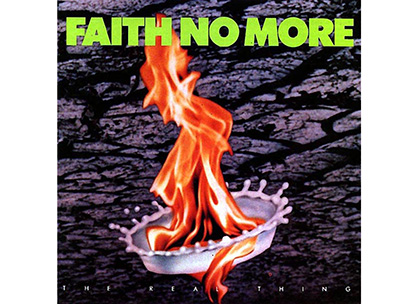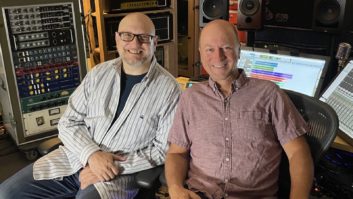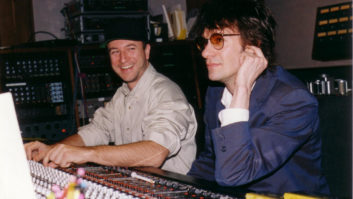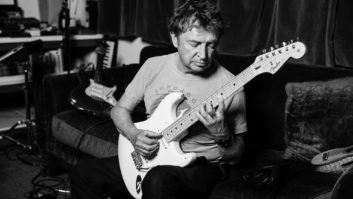
In early 1989, Matt Wallace almost quit being an engineer/producer. Nearly in tears, he called his mom to ask how to get into real estate. Wallace’s “failure” was producing, engineering and mixing Faith No More’s third album, The Real Thing, which went on to hit Number 11 in the U.S. and sell more than 4 million copies worldwide.
“I mastered that record with John Golden at K Disc Mastering [in Hollywood],” Wallace said. “It just sounded so bad on my home stereo and my car stereo. It was so high-endy and there was so much compression. I just thought I sucked and I didn’t know what the hell I was doing. Then lo and behold, on radio and MTV it killed. It was a perfect confluence of sounds and sketchy recording where it really jumped out of the speakers. It was just one of those happy accidents.”
Perhaps Wallace, who had about six years of producing records under his belt at the time, was just being his own worst critic, as many of us are apt to be. Either way, it would be about a year later when the serendipity of The Real Thing took full effect, as the album’s second single, “Epic,” blew kids’ minds just as completely as the piano blew up at the end of its iconic video.
Anyone of MTV-watching age in 1990 remembers the “Epic” video, which aired incessantly for a stretch. Although Faith No More was a somewhat established band with a minor alternative hit in “We Care a Lot,” the fresh combination of metal, funk and hip-hop in “Epic” seemingly came from out of nowhere, mixing different sounds of the day that should have been unmixable and making it sound natural. From the long-haired rapping white boy to the grandiose guitar solo to the dramatic piano outro while a fish out of water struggled for life in the video, “Epic” was powerfully weird and weirdly powerful. The single went Gold and hit Number 9 in the U.S., the band’s biggest hit.
Even though Wallace couldn’t predict the album and single’s eventual success when he was having his existential moment, he could have graded himself on a curve based on what he had to work with for the album. The Real Thing came from somewhat humble beginnings, but not as humble as Wallace and Faith No More’s true beginning.
“I started with those guys in 1982 in my parents’ garage,” Wallace said. “This tiny little suburban garage studio I put together.” During Wallace’s senior year at UC Berkeley, he was attending classes two days a week and making 8-track records in the garage four days a week. The first 7-inch as Faith No Man, including bassist Billy Gould and drummer Mike Bordin, was one of about 40 records Wallace produced at his folks’ house or at his studio after he moved it to neighboring Oakland.
With personnel changes, the band became Faith No More, adding Roddy Bottom on keyboards, Jim Martin on guitar and vocalist Chuck Mosley. Wallace produced their first album We Care a Lot (1985) over two three-day weekends—including mixing—at the 24-track Prairie Sun studios in Sonoma County, California, and then Introduce Yourself (1987) was recorded at Studio D in Sausalito and at Ground Control in Korea Town in Los Angeles.
For The Real Thing, the band and Wallace spent some time rehearsing the songs without lyrics or a singer in L.A. before heading back to the Bay Area to record at Studio D Recording in Sausalito. New singer Mike Patton had about two weeks to write lyrics before the sessions started.
Not only was Patton short on time, but Wallace and the band were short on gear. They had Bordin’s Yamaha drum kit and Wallace’s Slingerland Radio King snare drum, Gould’s Gibson Grabber bass going through a Peavey guitar head, Martin’s Gibson Flying V guitar and half-stack Marshall amp, Bottom’s E-mu Emax keyboard and the studio’s piano. “We had no options,” Wallace said. “That was it.”
Wallace recorded to a 24-track Studer A800 tape machine, through what he called “a really fantastic board,” a Trident A-Range console. They started off tracking the songs with a full band, mostly just to get the drums down. Wallace would then do razor blade edits before beginning overdubs, and he figures they overdubbed just about everything except the drums. Wallace miked the drums with a Shure SM57 on the snare, an AKG C 451 or 452 under the snare, an AKG D12 on the kick, Sennheiser MD 421s on the toms, Shure SM81s as overheads, an AKG C24 about six feet away from the drums and a pair of omnidirectionals—maybe AKG 414s—as distant room mics.
“I have to say 90 to 95 percent of that drum sound is Mike Bordin’s contact with the drums,” Wallace said. “He plays in a unique way; it’s really a wrist thing. His toms are very flat, and he always had bigger tom-toms than you’re ‘supposed’ to have.”
Wallace put a bit of compression on the snare, kick and the close room mics, and then a lot of compression on the distant room mics. “That’s where you get that amazing drum ambience and room ambience,” he said. “I had those separated out so in the mix I could blend them as needed. To me, the Faith No More sound is really the distance between Mike’s snare drum and the compressed room sound and the distance between the distorted, solid-state bass amp and the hallway, and then how much compression is on them.”
The speakers for the bass were in a hallway with a 421 mic tight to the cabinet, a condenser mic in the hallway and also a channel from a Countryman direct box. “Bill really attacks the bass,” Wallace said. “His pick, his overdriving Peavey solid-state guitar amp and the room ambience—it’s an aggressive sound, almost like you took a Marshall guitar amp and pitched it down an octave.”
For the album, Wallace and Martin spent at least a day trying around 26 mics in different positions and placements to get as many guitar tones that they liked out of Martin’s single guitar and amp. They recorded him in the only large iso room they used and blocked off the gear with yellow police tape once they had the setups they liked. Some of the mikings included a 414 tight to the speaker cone, a Shure SM57 off the speaker’s edge, a 421 on the back and flipped out of phase for a low thud, and some mics placed at distances. Their favorite tones were used for multiple tracks on the album.
Even though Martin always wanted more metal to the sound, every day he and Wallace would play the theme from Ennio Morricone’s The Good, the Bad, and the Ugly, salute each other and start working on guitar. “There’s nothing comparative sonically,” Wallace said, “but we wanted that feeling of grandeur, size and panorama when we did Faith No More.”
“Epic” specifically took two or three days in the studio to finish, including initial tracking, edits and overdubs. They already had a great demo to work off of that Gould made beforehand, which even included the piano outro. In the final recording, the piano outro is Bottom playing the miked-up studio piano for the melodic top end, and Gould playing plinky chords on the direct-recorded 8-bit sampling Emax keyboard.
Gould’s impeccable composition and Martin’s blistering guitar notwithstanding, one has to wonder if “Epic” would have been such a hit without Patton’s esoteric lyrics, commanding presence and distinctive voice. Wallace recalled that between takes, the vocally elastic Patton would switch from the nasally, whiny voice from the chorus of “Epic” to a deep and rich R&B-style crooning. Wallace wanted him to try that voice on the recording, but Patton refused.
“Honestly, Patton was right, because that kind of adolescent, bratty thing he did was absolutely right for that song,” Wallace said. “If we had gone my way, I don’t think it would have connected like the version we did. Patton was right in sticking to that irritating, kind of ‘f*ck you’ vibe on his vocal. I think young people connected with it because he was singing the way young people thought of the world, like, ‘no one understands us.’”
Patton’s aggressively delivered verses influenced the choice of vocal mic: a Neumann U 47 FET condenser, rather than a tube mic, because of the sonic pressure he was putting into it. “I recorded Patton’s vocal through a dbx 166, which is not a great compressor,” Wallace said. “It was a stereo/dual compressor, so I’d run his vocal through one end of it as a compressor, back into the other side of it as a limiter, and then to tape. So we hyper-compressed him to tape and then during the mixing phase, I used that same 166 again on his vocals. So his vocal was compressed twice to tape, twice during mixing, and then it went through the bus compressor. Not really hi-fi, but that record had a sound that was very aggressive yet still melodic, and we really went for something.”
They went for something, but “what… is… it?” That question confounded almost everybody who heard “Epic,” a real love-it-or-hate-it type of genre-bending track when it came out. Wallace said their associates at Warner Bros. liked it but thought it would never receive radio play. It had a radio-unfriendly 44-second instrumental interlude in the middle and a bit of a raw mix.
“It was always a challenge to go through the frequencies and try to make it so the bass and the electric guitar didn’t get in each other’s way,” Wallace said. “Then I was trying to keep the keyboard at the upper midrange on up, to keep it away from the guitar. Oftentimes they would all play 100 percent for a good portion of their songs, so I’d always have to do subtractive mixing or subtractive equalization to try to find ways to weed things out.”
However, when the label had Wallace do a radio remix version of “Epic” with more polish and less instrumental, it went nowhere. “The remix has tremendous low end on it and also has more hi-fi reverb,” Wallace said. “Honestly, it’s technically better. It sounds more like, ‘now winning the Grammy for engineering, Matt Wallace.’ But everyone still loves the original version, because it’s scrappier. As much as I wish people had used that remix, by the time it got out, radio had already jumped onboard the original album version. Honestly, the original version just worked. It didn’t sound too pro.”
Perhaps it was that alternative hits in the era of “Epic” are like viral videos today: everyone wants to make one but has no idea how to do it until it’s done.
Wallace went on to produce Faith No More’s follow-up to The Real Thing and the band’s most critically acclaimed album, Angel Dust, and he still hasn’t quit producing. Among his many credits are the multiplatinum-selling Songs About Jane by Maroon 5, Train’s first album, Andy Grammer’s first album, two albums with O.A.R., and he’s now working with young bands like Los Angelics, R5 and RapScallions. Faith No More just released its first album in 18 years, Sol Invictus, on May 18, which was mixed by Wallace and Bill Gould. The fish from the “Epic” video, Morty, is retired and living in Lake Tahoe.






